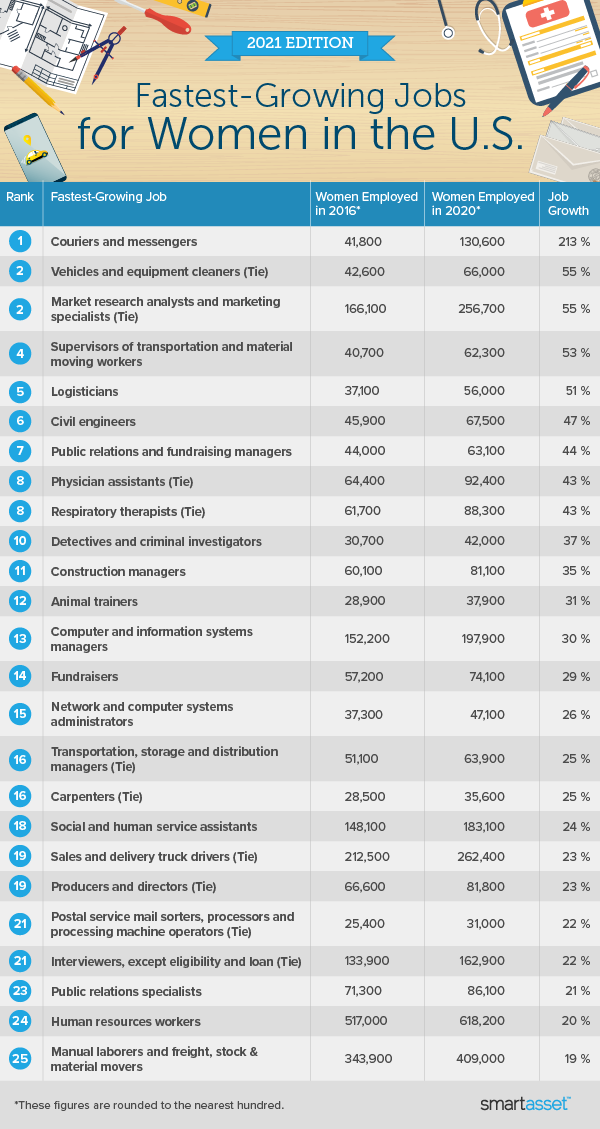
According to Bureau of Labor Statistics (BLS) data, in January of 2021 the labor force participation rate for women dropped to 57%. This was the lowest it had been since 1988, when it fell to less than 58% (compared to when it reached above 60% in the late 90s and into the aughts). It is believed that the childcare crisis, driven by pandemic-related daycare and school closures, has caused many women with children to leave their jobs. Some jobs, though, are seeing an increase. SmartAsset crunched the numbers to see which professions are gaining in their ranks of women workers.
To find these professions, we looked at BLS employment figures for 2016 and compared them to 2020. For more details on how we found and analyzed our data, read the Data and Methodology section below.
This is SmartAsset’s third annual study on the fastest-growing jobs for women in America. Check out the 2020 version here.
Key Findings
- In general, a rising tide has lifted more boats. Generally, the jobs that saw increases for employment among women also saw big increases across the population. There are a number of exceptions, though. Across the 167 jobs we looked at, 11 of them saw an uptick in the percentage increase in number of women employed, but a decrease or no change in the number of people employed overall. Some of these jobs include civil engineers, carpenters, court clerks, chemical technicians, human resource managers, janitors and clergy.
- There are eight professions in which women’s employment has decreased, but overall numbers have not. The jobs in the study that lost total employment also generally saw a decrease in women workers. There are eight jobs in which there was a decrease in the percentage of women workers, but either an increase or no change in the percentage of people employed overall. Some of these jobs include dentists, probation officers, technical writers and phlebotomists.
- Couriers and messengers hold the top spot by a significant lead. In last year’s version of this study, courier/messenger was the fastest-growing job for women with a four-year growth of 148%. This year the lead is even stronger, at about 213%. For comparison, the No. 2 spot, held by vehicle and equipment cleaners, saw growth of less than 55% over the same time frame.
1. Couriers and messengers
In 2016, there were 41,768 women working as couriers and messengers. By 2020 that number had gone up 212.75%, with a total of 130,628 women working in the field.
2. Cleaners of vehicles and equipment
In 2020, 66,048 women worked cleaning vehicles and related equipment. That’s 23,408 more than the 42,640 who did so in 2016, a 54.9% jump. This is a field where the increase in women far outpaced the overall growth, which sat at just 4.88% between 2016 and 2020.
3. Market research analysts and marketing specialists
Women are increasingly filling market research analyst and marketing specialist positions, which take the No. 3 spot in our study. There were 166,100 women in these positions in 2016, and by 2020 that had gone up 54.53% to 256,668.
4. Supervisors of transportation and material moving workers
Supervising transportation and material moving workers saw an overall employment increase of 39.47% in between 2016 and 2020. In terms of women workers, employment went from 40,660 to 62,275, a 53.16% jump.
5. Logisticians
Logisticians help a company analyze and optimize their internal logistics. There were 37,145 women filling these roles in 2016. That went up 50.78% by 2020, when 56,007 worked as logisticians.
6. Civil engineers
The total number of civil engineers actually decreased from 425,000 to 422,000 from 2016 to 2020, making it the only role in the top 10 of this study to see a decrease. The number of women working as civil engineers, though, went up 47.10% during that time – from 45,900 to 67,520.
7. Public relations and fundraising managers
Public relations and fundraiser managers help make sure a business interfaces well with the public. The number of women in these jobs went from 43,958 to 63,080 between 2016 and 2020, a 43.50% jump. Women make up 66.4% of this field.
8. Physician assistants
Physician assistants work alongside doctors and nurses to care for patients. This is another job where women are the majority, making up 65.5% of the field in 2020. The number of women working as physician assistants was 64,400 in 2016 and had increased to 92,355 in 2020, a 43.41% increase.
9. Respiratory therapists
Here we have another medical field where women make up the majority of the field – 72.4%, the highest percentage in this study’s top 10. There were 61,740 female respiratory therapists in 2016. That number climbed to 88,328 in 2020, a 43.06% increase.
10. Detectives and criminal investigators
This is a field where women are still a fairly small minority, making up just 26.4% of detectives and criminal investigators. Still, there has been progress, with the number of women in these jobs increasing 36.82% between 2016 and 2020, jumping from 30,680 to 41,976.
Data and Methodology
To find the fastest-growing jobs for women, SmartAsset analyzed employment data from 2016 and 2020, the most recent year for which detailed occupational employment data is available. We filtered out any occupation that employed fewer than 25,000 women in 2016. We also filtered out any occupation with “other” or “miscellaneous” in the title due to lack of occupational specificity. We used the four-year percentage change in women employed in each occupation to rank all the jobs, from highest percentage increase to lowest.
All data comes from the Bureau of Labor Statistics (BLS).
Tips for Managing Your Money and Career
- Seek out expert advice. No matter what job you have, a financial advisor can help you make the most of the money you bring in. SmartAsset’s free tool matches you with up to three financial advisors in your area, and you can interview your advisor matches at no cost to decide which one is right for you. If you’re ready to find an advisor who can help you achieve your financial goals, get started now.
- Understand the tax consequences. A new job can mean a different salary, and with that comes new tax implications. Use SmartAsset’s free income tax calculator to see what your payment to Uncle Sam might look like.
- Take advantage of every opportunity to save for retirement. Changing jobs can also mean new retirement planning options. If your new job has a 401(k) offered, take advantage of it – and make sure you are getting any employer match that is available to you.
Questions about our study? Contact press@smartasset.com.
Photo credit: ©iStock.com/PeopleImages
